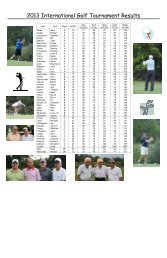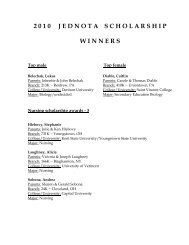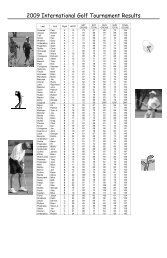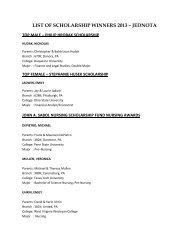Inside - First Catholic Slovak Union
Inside - First Catholic Slovak Union
Inside - First Catholic Slovak Union
Create successful ePaper yourself
Turn your PDF publications into a flip-book with our unique Google optimized e-Paper software.
PAGE JEDNOTA, WEDNESDAY, MARCH 31, 2010<br />
Insights and Viewpoints<br />
Should the <strong>Slovak</strong> Nation Honour Tomáš G. Masaryk<br />
By Stanislav J. Kirschbaum, FRSC<br />
The Canadian-<strong>Slovak</strong> weekly, Kanadský Slovák, recently published a letter expressing<br />
opposition to the decision by the mayor of Bratislava to erect a statue in front of the <strong>Slovak</strong><br />
National Museum in Bratislava commemorating Tomáš G. Masaryk, the first President<br />
of Czecho-<strong>Slovak</strong>ia. It is one of many open protests published in <strong>Slovak</strong>ia. The decision<br />
launched a debate that centers on the question whether Masaryk should be recognized<br />
as a major personality in <strong>Slovak</strong> history that deserves to be thus commemorated. It is a<br />
question worth closer examination.<br />
There are two issues at stake: <strong>First</strong> of all, whether any official personality from the<br />
defunct Czecho-<strong>Slovak</strong> Republic should be commemorated in this way in <strong>Slovak</strong>ia Secondly,<br />
whether Tomáš G. Masaryk, as its founder, has in fact played a role significant<br />
enough in <strong>Slovak</strong> history to entitle him to more than an appropriate mention in history<br />
books<br />
The answer to the first question is best given from a comparative point of view. Until the<br />
twentieth century and even for the better part of it, the <strong>Slovak</strong> nation lived in cohabitation<br />
with one or more nations in one state. The <strong>Slovak</strong>s lived in the Hungarian Kingdom for<br />
over a thousand years, contributed to its development, but were also subjected to assimilatory<br />
policies that in the end pushed them to leave the kingdom and find a way to govern<br />
themselves. The Magyarization of the <strong>Slovak</strong>s marked the nineteenth century but up to<br />
that point, although there were clashes, <strong>Slovak</strong>–Hungarian relations were such that both<br />
nations benefited from them. Apart from the castles and residences throughout <strong>Slovak</strong>ia<br />
that the Hungarian magnates built, there is only one statue that bespeaks of the <strong>Slovak</strong>-<br />
Hungarian period, the one in Košice of František Rakoci (Ferenc Rakoczi) II, župan of<br />
Šariš county, leader of the last of the magnate rebellions. There is no existing statue of<br />
St. Stephen, the first Hungarian King and founder of the kingdom. However, since 2009,<br />
<strong>Slovak</strong>ia’s Hungarians in Komárno have been collecting funds to erect one there. It will be<br />
interesting to see whether this happens.<br />
Czechoslovakia – the other state in which the <strong>Slovak</strong>s cohabited with another nation,<br />
the Czechs – broke up on 31 December 1992. It had existed for a total of 68 years (1918-<br />
1939 and 1945-1992). It was a country that, like Hungary, gave much to the <strong>Slovak</strong>s, yet<br />
they never became the equal partners they had hoped to be when they joined. In 1918,<br />
Andrej Hlinka spoke of the <strong>Slovak</strong>-Hungarian relationship as a “thousand year marriage;”<br />
the Czech-<strong>Slovak</strong> one was a 74-year marriage with a 6-year separation. There are vestiges<br />
of the Czechoslovak past in <strong>Slovak</strong>ia, for example the former presidential summer<br />
residence in Topoľčianky and the column with the Czech lion on top in front of the <strong>Slovak</strong><br />
National Museum in Bratislava. The statue to Masaryk is to replace it.<br />
<strong>Slovak</strong>ia has erected over the years statues to honour historical personalities, but generally<br />
<strong>Slovak</strong> ones. Trnava has a statue of General Milan Rastislav Štefánik and one of<br />
Anton Bernolák. The city of Žilina has a number of statues in its main square and Nitra<br />
has one of SS Cyril and Methodius. There are many more examples throughout <strong>Slovak</strong>ia.<br />
And they all point to the fact that the <strong>Slovak</strong>s prefer to celebrate their own personalities,<br />
rather than those who were not <strong>Slovak</strong>, however important their role in <strong>Slovak</strong> history. It<br />
vvv vvv vvv<br />
Reflections on Our Christianity<br />
continued from page 2<br />
Then he put them all out.” (vss. 39 – 40). He said to the twelve year old, “Little girl, get up.”<br />
(vs. 41) “He enjoined them strictly not to let anyone know about it, and told them to give her<br />
something to eat.” (vs. 43)<br />
“Who touched my clothing” (Mark 5:30)<br />
“Please, Lord,” she replied. “even the dogs under the table eat the family’s leavings.<br />
Then he said to her, “For such a reply, be off now! The demon has already left your daughter.”<br />
(Mark 7:28-29)<br />
“Then he began to be filled with fear and distress. He said to them, ‘My heart is filled with<br />
sorrow to the point of death. Remain here and stay awake.’ He advanced a little and fell to<br />
the ground….” (Mark 14:34-35)<br />
His disciples were critical of him.<br />
“They finally woke him and said to him, ‘Teacher, does it not matter to you that we are<br />
going to drown’.” (Mark 4:38)<br />
“Are we to go and spend two hundred days’ wages for bread to feed them” (Mark 6:37)<br />
“His disciples said to him, ‘You can se how this crowd hems you in, yet you ask, ‘Who<br />
touched me’” (Mark 5:31)<br />
“Hear me, all of you, and try to understand. Nothing that enters a man from the outside<br />
can make him impure; that which comes out of him, and only that, constitutes impurity. Let<br />
everyone heed what he hears.” (Mark 7:14-16)<br />
“His disciples replied, ‘How can anyone give these people sufficient bread in his deserted<br />
spot” (Mark 8:4) Then, Jesus asked them how many loaves they had and they replied,<br />
“seven.” (Mark 8:5)<br />
“Peter then took him aside and began to remonstrate with him. At this, he turned around<br />
and, eyeing the disciples reprimanded Peter: ‘Get out of my sight, you Satan! You are not<br />
judging by God’s standards but by man’s’!” (Mark 8:32-33)<br />
For your meditation, place yourselves personally in each of these scenes.<br />
is also interesting to note that statues imposed on them were destroyed: in 1921 that of<br />
Empress Maria Theresa and in 1990 that of Klement Gottwald, both in Bratislava. One<br />
exception is the statue of Masaryk that once stood in Nitra; it is found today in the former<br />
presidential residence in Topoľčianky. Clearly, the <strong>Slovak</strong>s have a tradition of choosing<br />
only <strong>Slovak</strong> personalities.<br />
Did Masaryk play a role in <strong>Slovak</strong> history that warrants honouring him in the same way<br />
as <strong>Slovak</strong> personalities It is said that he was half <strong>Slovak</strong> (his mother) and yet his entire<br />
political life was devoted to the Czech nation. He was indeed the founder of the common<br />
state of the Czechs and <strong>Slovak</strong>s, but he also believed that this state would forge in time<br />
one nation, the Czechoslovak nation, essentially bringing about the assimilation of the<br />
<strong>Slovak</strong> nation into the Czech. It is, therefore, very difficult to conclude anything other than<br />
that he did not have an appropriate appreciation of the <strong>Slovak</strong>s and their history. Had he<br />
had a realistic picture and, above all, acted accordingly, the <strong>Slovak</strong>s would not have twice<br />
left the state that he founded, in March 1939 and again in December 1992 St. Stephen’s<br />
kingdom existed for a thousand years: Masaryk’s state first broke up within one generation.<br />
Such a record hardly warrants a statue in <strong>Slovak</strong>ia.<br />
<strong>Slovak</strong>ia faces in the next few decades many challenges of an economic, social, and<br />
political nature. To understand their past is one of them, given the repeated distortions of<br />
history to which the <strong>Slovak</strong>s were subjected throughout the twentieth century. <strong>Slovak</strong>ia’s<br />
political elite and, indeed, its population, will not be served by a focus on a state that no<br />
longer exists and by analyses that fail to explain what brought the <strong>Slovak</strong>s to point where<br />
they are today. The fate of the <strong>Slovak</strong>s has always been in their own hands, however<br />
much or little others helped. Now, it is more so that ever before. I do not think that a statue<br />
commemorating Masaryk would bring that point home.<br />
vvv vvv vvv<br />
Branch 89 Museum Outing in<br />
Milwaukee, Wisconsin<br />
The Knights of St. Mary & Joseph Branch 89 will have an outing to the Milwaukee Public Museum<br />
on Sunday, April 18, 2010 at 1:00PM sharp to see the Dead Sea Scrolls and The Bible Exhibition.<br />
This is a timed entry, so attendees need to be there at 12:30 so the group can go into the exhibit at<br />
the scheduled hour (1:00PM).<br />
Tickets must be purchased in advance for groups, so you must make an advanced reservation to<br />
attend this event by April 7, 2010. Please call President Michael Novak at 414-445-5382 to reserve<br />
your spot.<br />
Tickets for members are free; guests are welcome but must pay the face value of the ticket, or $26<br />
per attendee. Make checks payable to: Knights of St. Mary & Joseph Branch 89. Mail checks to: Mike<br />
Novak, 3237 N. 93rd Street, Milwaukee, WI 53222.<br />
Mike Novak, President<br />
NEWSPAPER DEADLINES<br />
All copy is due by 4:30 P.M., THE MONDAY BEFORE THE ISSUE DATE, unless<br />
otherwise stated below because of special holiday scheduling. Copy that is<br />
not received by this deadline will not necessarily appear in the following<br />
Wednesday’s issue.<br />
Issue Date<br />
Copy Date<br />
WEDNESDAY, APR 14 MONDAY, APR 5<br />
WEDNESDAY, APR 28 MONDAY, APR 19<br />
WEDNESDAY, MAY 12 MONDAY, MAY 3<br />
Correspondents who are announcing upcomoing events should remember<br />
that the JEDNOTA is printed EVERY OTHER WEDNESDAY, and should<br />
take into account the extra time lost in the postal system. Therefore,<br />
please plan to have your announcements to us in ample time for them to<br />
be printed and received by the readership.<br />
Send all copy (English AND <strong>Slovak</strong>) to:<br />
Teresa Ivanec, Editor; fcsulifeeditor@gmail.com<br />
<strong>First</strong> <strong>Catholic</strong> <strong>Slovak</strong> <strong>Union</strong>, Attention “JEDNOTA”<br />
6611 Rockside Road, Suite 300, Independence, OH 44131-2398<br />
FAX: 216-642-4310



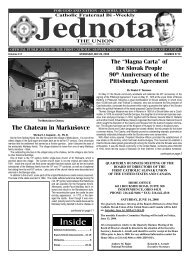
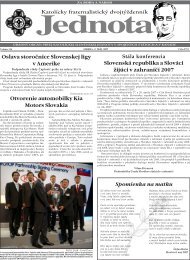
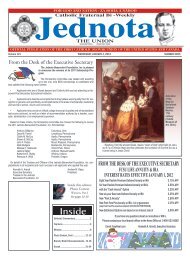
![Kardina;l Tomko na levoc'skej pu;ti zdo]raznil vy;znam manz'elstva U ...](https://img.yumpu.com/50723466/1/190x260/kardinal-tomko-na-levocskej-puti-zdoraznil-vyznam-manzelstva-u-.jpg?quality=85)




